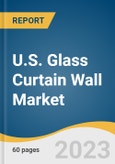The growing consumer demand for innovative buildings equipped with modern technologies and having improved aesthetic appeal and energy efficiency is expected to drive the usage of glass curtain walls in residential establishments in the U.S. over the forecast period. Moreover, there is growth in the construction of green buildings in the country owing to the rising awareness among the masses about the benefits of energy-efficient buildings that have improved indoor air quality. This is projected to drive sustainable building construction activities in the U.S., thereby positively impacting the demand for curtain walls in the country owing to their low volatile organic compound (VOC) emissions.
The market for glass curtain wall products is being influenced by the challenges faced by the construction industry as a whole, which is experiencing significant pressure due to a shortage of skilled and qualified laborers in the country. Lack of labor results in a significant lengthening of installation time, resulting in a surge in cost.
The U.S. market for glass curtain walls is characterized as highly competitive owing to the presence of both regional and multinational players. The key players are investing in improving the quality of their products, technology advancements, and enhancing their manufacturing capacities. They are also carrying out regional expansions to strengthen their presence in the market. Product quality, technical innovation, design capabilities, project management expertise, pricing, and customer service are factors affecting competition in this market.
U.S. Glass Curtain Wall Market Report Highlights
- The glass curtain wall market in the U.S. was dominated by unitized systems, accounting for USD 5.80 billion in 2022. The demand for modern and aesthetically appealing building designs is expected to increase the utilization of glass curtain walls. Unitized systems offer flexibility in design options, allowing architects to create visually striking facades. Investment in high-rise buildings, such as 98 Red River Street by KPF, Waldorf Astoria Miami by SSA/Carlos Ott, and Seattle Tower by ODA, is expected to drive segment growth
- The commercial end-use segment is expected to grow at the highest CAGR of 6.1% over the forecast period. This growth is driven by factors like economic conditions, construction activities, and sustainability trends. The market is expected to be driven by strong economic conditions and increasing construction spending on commercial buildings
- The U.S. construction industry has experienced significant growth due to urbanization, population growth, and infrastructural developments. The demand for commercial, residential, and industrial buildings has increased, leading to the adoption of modern construction techniques and materials. Glass curtain walls are gaining popularity as an architectural solution, offering natural light, aesthetics, and improved energy efficiency. These systems minimize heat transfer, reduce environmental footprint, and can incorporate solar panels, contributing to green building initiatives and reducing reliance on traditional energy sources
- The country’s growth is driven by rising construction activities and modern architecture. Energy-efficient building demand, driven by sustainability and cost savings, drives the adoption of glass curtain walls. Developers and architects are drawn to modern architectural designs and transparent facades. Urbanization and population growth create opportunities for glass curtain walls in high-rise buildings and commercial spaces
- Key glass curtain wall manufacturers in the U.S. are adopting various growth strategies to keep up with the rising demand from various end-use applications. To gain further access to the global and regional markets, companies are forward integrating along their value chain. Most of the key market players are focusing on enhancing their distribution channels by renewing their existing marketing contracts and forming new agreements with local distributors to gain a competitive advantage
Table of Contents
Companies Mentioned
- Viracon
- Apogee Enterprises Inc.
- Guardian Industries
- Trulite
- Kawneer (U.S.)
- YKK AP America Inc.
- Accura Systems, Inc.
- Technical Glass Products
- Kalwall
- Lockheed Architectural Solutions, Inc.
Table Information
| Report Attribute | Details |
|---|---|
| No. of Pages | 60 |
| Published | September 2023 |
| Forecast Period | 2022 - 2030 |
| Estimated Market Value ( USD | $ 8.26 Billion |
| Forecasted Market Value ( USD | $ 13.8 Billion |
| Compound Annual Growth Rate | 6.6% |
| Regions Covered | United States |
| No. of Companies Mentioned | 10 |









